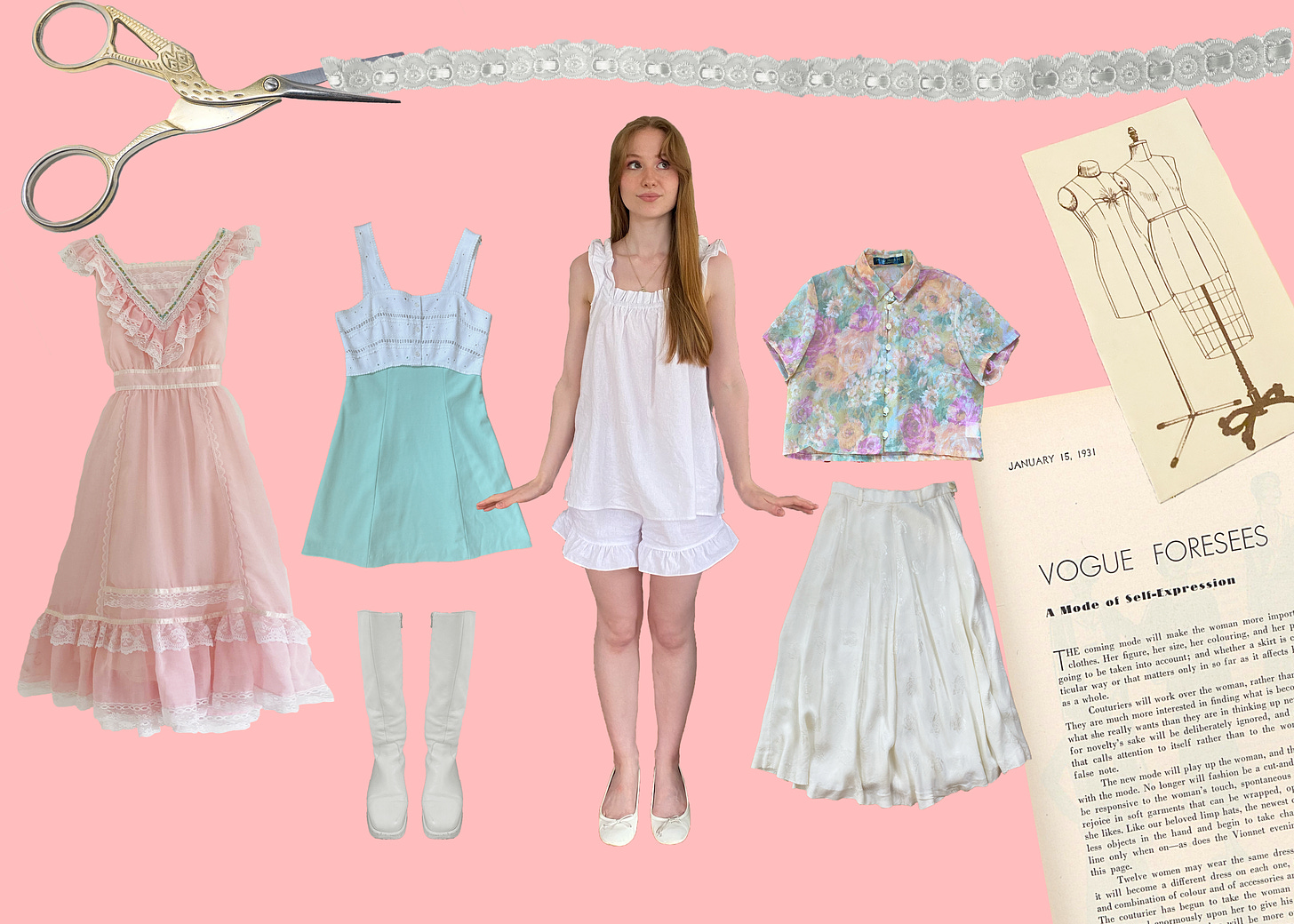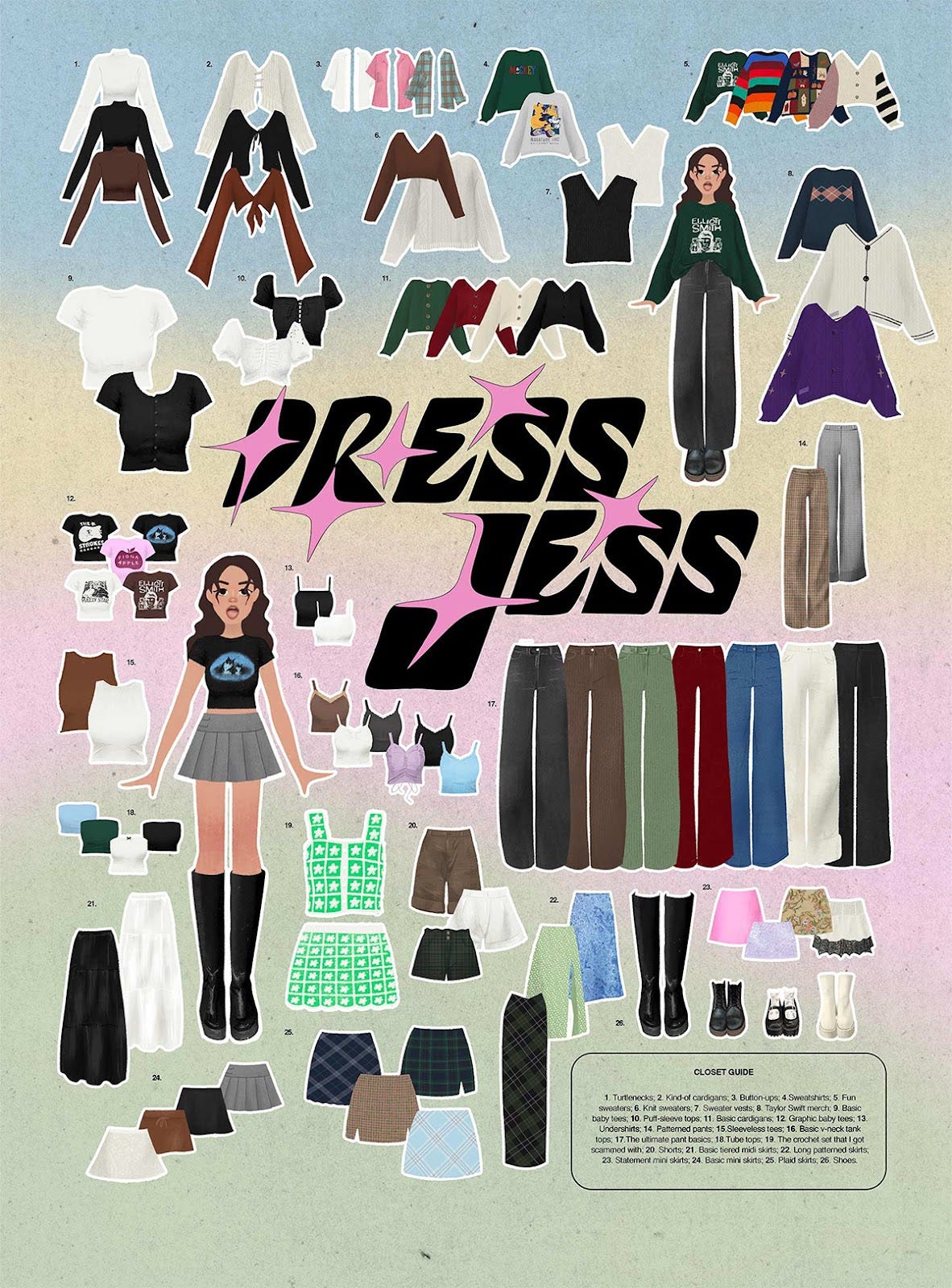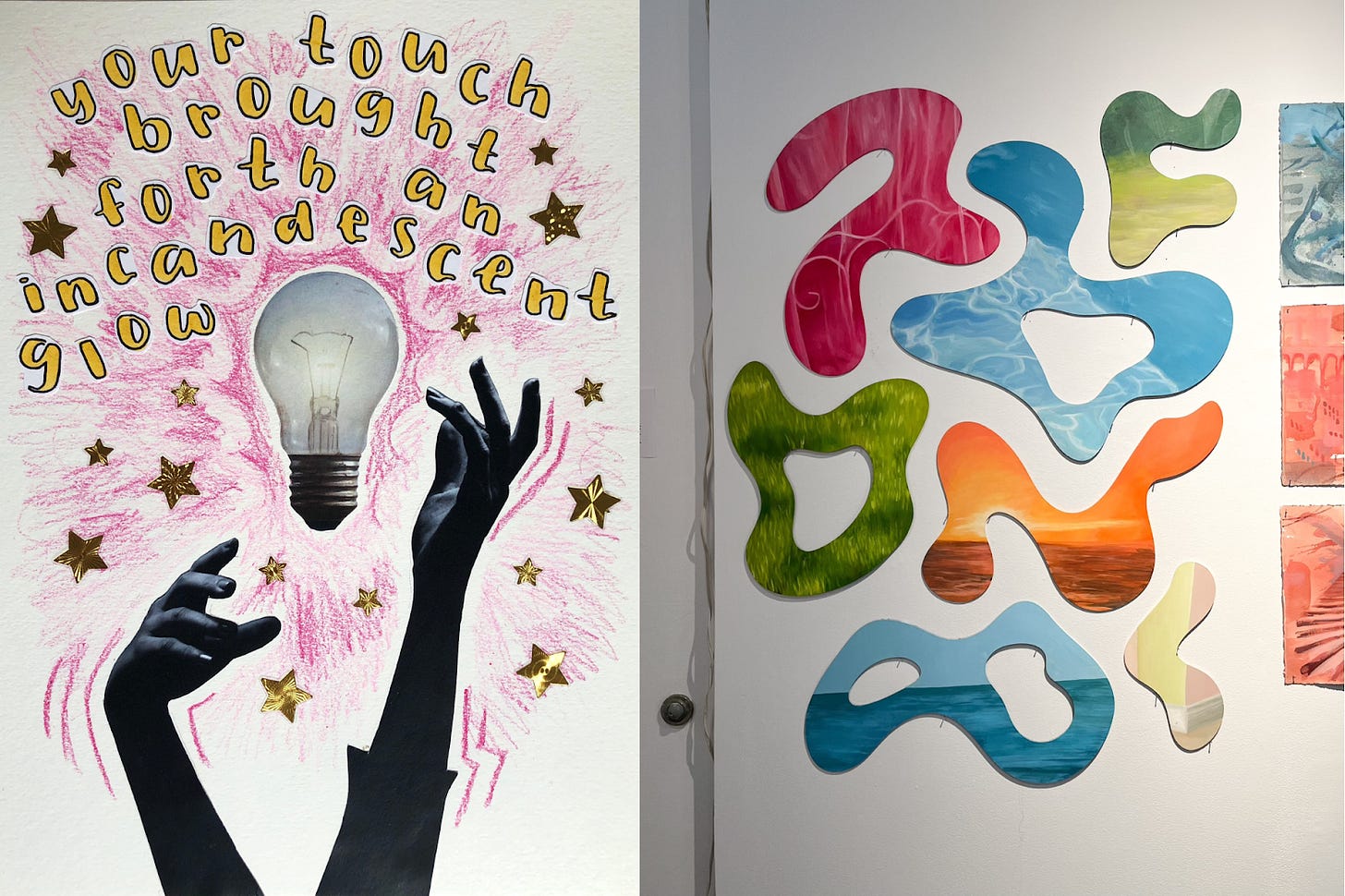Playing Dress-up with Jess Bosnjak
On accidental content creation, fashion as collage, and playing with mediums
Young creatives are constantly encouraged to showcase their work online, but actually doing so can be labyrinthine and double-edged. The algorithms governing social media platforms constantly try to redefine and reshape us, finding new ways to sell us to new audiences. I spent nearly three years creating sewing, personal style, and fashion analysis videos after accidentally building an audience through a handful of viral TikToks (an earth-shattering confession, I know). Filming and editing footage of my creative processes made for a fun hobby outside of my work and research, but I eventually burned out and gravitated back towards my most comfortable medium: writing. In my current state of intense internet-oriented disillusionment, I’ve been reflecting on my own creative past and future lately, and pondering questions of authenticity, artistry, and what it presently looks like to be a creative person online. In my attempt to answer some of these questions, I decided to create an interview series with people approaching fashion and creation from many different angles, featuring academic researchers, content creators, freelance writers, designers, and more.
My first conversation is with Jess Bosnjak, an illustrator, designer, and fashion content creator based in Oakville, Ontario. Like many older members of Gen Z, Jess grew up playing on GirlsGoGames, a platform hosting thousands of flash games targeted towards tween girls. (I, for one, was obsessed with their dress-up games and would wake up early to play them on the family computer before school.) Looking for a way to combine illustration, social media, and fashion, Jess decided to revive this childhood activity by designing, coding, and developing her very own nostalgic dress-up game as part of her bachelor’s thesis. Featuring over 90 hand-drawn replicas of Jess’ own clothing, “Dress Jess” now has 316,000 plays on TikTok and has quadrupled her audience over just a few months. The twist? Most new fans of Jess are pre-teen children.
I wanted to chat to Jess about her experience in the online fashion world. Our conversation covers accidental content creation, unanticipatedly young audiences, the performativity of fashion content, being put into a style box, the intersection between music and fashion, and tips for finding discounted vintage. I will be releasing the full 40-minute interview (filmed in May 2024) soon for paid subscribers,* but some of my favourite highlights are included in my reflection below.
“I'm curious,” I probed early on in our conversation. “Did you originally set out to post about fashion or art, or did you fall into this?”
She laughed. “Oh, this is so funny you brought this up… I'm an illustrator, and I wanted to get my art out there, so I thought TikTok was the place. I had never had TikTok before, so I downloaded it, and... nothing happened… Not even my friends would see my posts, so I was like, ‘okay, I give up – I'm just going to post outfits that I like because no one can see them anyway.’ For some reason, the third one I ever did got a million views. I don't know why! I gained a bit of a following and then it's just been growing ever since.”
I had a similar dream of leveraging social media to help pursue my creative endeavours, so this is one of the questions I was most excited to ask Jess. “That’s not what I wanted to do either,” I confessed. In 2020, I started selling my handmade jewellery on Etsy, and I joined TikTok with the hope of showcasing my pieces and eventually listing some sewing projects. I posted consistently over a year and gained a couple thousand followers, but the labour I put into creating videos was difficult to sustain on top of my work and class schedule, especially with minimal results. On a whim, I started posting lower-effort videos of outfits I was already wearing, and those took off. My plan was to showcase my jewellery through my outfit content, but even as my account skyrocketed, the algorithm was captivated solely by the clothes.
“I think the world might be a bit more receptive to outfits and faces,” Jess offered.
She’s right. TikTok loves the idea of “creating a new shopping culture,” as they noted in the press release for TikTok Shop’s rollout, and create a new shopping culture they did! Plenty of fashion TikTokers are disinterested in selling things, but – as I’m sure we all know by now – the algorithm heavily favours sales pitches and novelty items.
I think many young artists and creatives see online momentum as something that can be turned into exposure, a path forward for what we really care about. Quickly, however, many of us realize that such momentum – for the vast majority – is a currency without exchange value.1 Affiliate links and products we can run-don’t-walk to will consistently trump the algorithm. I am very sympathetic to many points made in Emily Sundberg’s recent piece, “The Machine in the Garden,” but I wish we could have more conversations around those who saw content creation – by nature of our terrible economic landscape and strange digital age – as the necessary first step towards becoming the writer, artist, or whatever type of creative they had originally hoped to be.
I asked Jess about the intersection between her style and other mediums of art, since she has so successfully synthesized the different aspects of her creative output.
“For my entire life, art was my hobby,” Jess said, “but now that’s for work, for school.” Like many creatives after monetizing their hobbies, Jess needed an outlet outside of professional pressure. She found this in collage, as “it's easier to just pull things that already exist and just rearrange them rather than making something brand new.” Music was her chief source of inspiration. “What does this song look like?” she would ask herself when approaching a new piece. “If it was a thing you could look at, what would it look like?”
Her newfound love for collage changed her approach to fashion, too. “For me, fashion is collage,” she explained. “I'm taking things that already exist and I'm just… creating a vibe with them in the way that I would make a collage or an illustration, but I'm just really reducing things to their simplest form.”
I love this perspective – I remember looking at collage spreads in fashion magazines as a child, mesmerized by their artsy-yet-chic formulations. Collage is a classic fashion medium, and one that I think really helps us reject the whims of the algorithm. By hunting and gathering images across eras, you’re forced to look for a wide variety of pieces – stickers and trims and old pieces of things that can be reused and repurposed and reimagined into something new. The eclecticism of collage invites us to make aesthetic connections, to mix and match essences and vibes, taking inspiration wherever you find it instead of copying exact outfits.
“Dress Jess” has helped Jess begin to reintroduce art into her content, and I think the game also really captures the spirit of collage. Users are encouraged to mix and match different pieces on the paper doll-style avatar, all of which come from Jess’ own closet, which is primarily second-hand and so cannot simply be purchased through a convenient affiliate link.
I am currently in a mild outfit slump and have been eager to be more playful with my fashion, so I experimented with “Dress Jess” to see how the dress-up game spirit could help me. I had two main takeaways: 1) I wish I had a hand-drawn, digital version of my wardrobe, and 2) experimenting with clothes that were completely different than mine actually helped me get out of my head. I noticed that I tend to make rigid fashion rules for myself (“this skirt must always be paired with a turtleneck,” or “that top can only be worn with brown pants”), and being forced to break out of them really helped me approach my outfits with the curiosity and play my colourful style has been screaming out for.
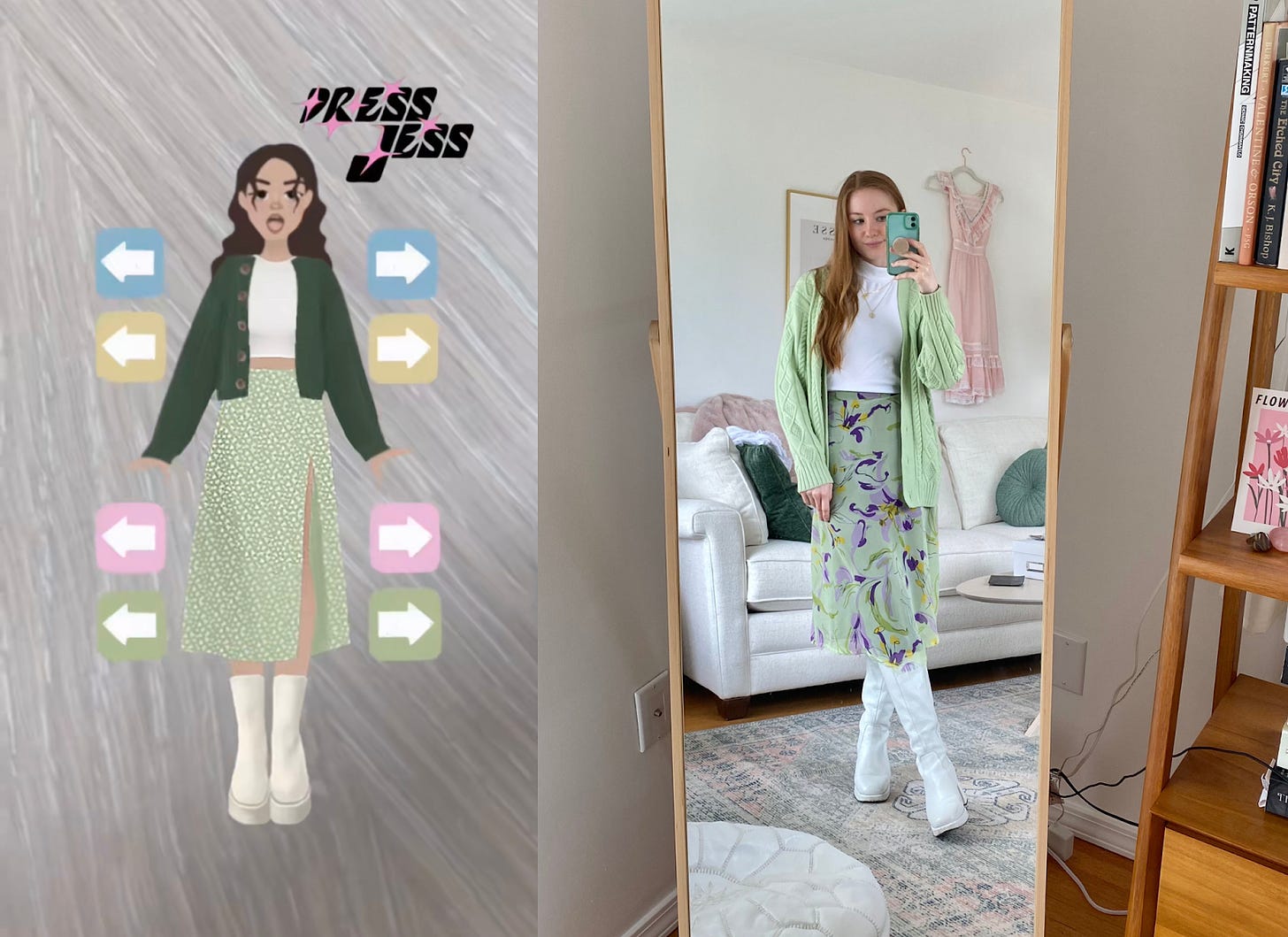
Jess also wants to do a concert-themed version of her game in order to play around with musical fashion influences. She shared that Olivia Rodrigo – who Jess had a chance to meet in Toronto! – is one of her main sources of style inspiration. Jess loves how Rodrigo blends sparkle and edge, pairing “cutesy and dainty” elements with “fishnets or chunky jewellery.”
We discussed how playful Rodrigo’s looks often are, and how recent concerts seem to have encouraged a more playful relationship with fashion in general. Between recent stadium tours featuring Harry Styles, Taylor Swift, Chappell Roan, Beyoncé, and Olivia Rodrigo, going all out for concert outfits has become increasingly widespread, with more and more fans planning elaborate DIY outfits. After our sad, beige pre-COVID era, it has been so nice to see playful, theatrical styles spreading into mainstream fashion, and music seems partly responsible for this shift.
Much like Olivia Rodrigo herself, Jess has developed something of a cult following among very young viewers. Jess is 22, and her content has always been made with her peers in mind. “But the people who interact with my content now, [. . .] they're kids,” she shared. Rather than primarily attracting other Gen Z users looking to indulge their nostalgia, Jess’ videos have been pushed to a wide range of tweens and children under 12, a new generation eager to play the dress-up games of our youth. “I've had my TikTok blow up a lot lately, but it's just all kids, so they're the kinds of people who are engaging with things like ‘what aesthetic is this?’”
I shared her irritation towards TikTok’s obsession with generating new hyper-specific aesthetics. Amateur trend forecasting is certainly partially to blame for this, but it’s frustrating when users internalize this thirst for categorization, particularly in online corners dedicated to finding a style or taste outside of the internet.
“My biggest pet peeve on the internet is that everything is something-core, something aesthetic,” Jess told me. “Everything has a specific name that you could type into a search engine, and I think we're just dealing with the first generation of kids who have always had Google around, so they can just type anything in.”
Jess’ videos are generally playful, focusing less on one fashion philosophy, but she places an emphasis on secondhand clothing and her own personal style. It’s funny, though – no matter how much you say, “hey, this is my personal style,” TikTok audiences (especially young ones) are often eager to categorize creators or ask for searchable aesthetic categories. I’m sure that most people reading long-form fashion content would agree that an over-reliance on aesthetics can be counterproductive, but this critique is not so ubiquitous on TikTok and hasn’t made a discernible impact among the kids and teens continuing to spread it. I really love how Jess is trying to educate young viewers whose first impressions of fashion and shopping have been shaped by the algorithm, even if some people struggle to listen.
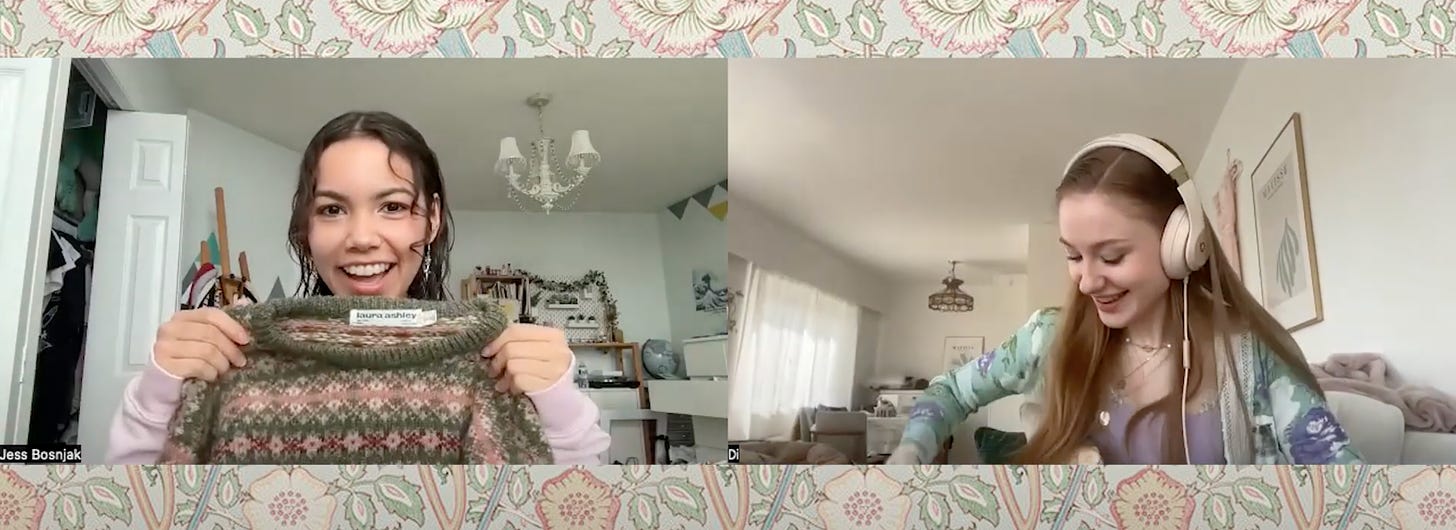
For Jess, the transition has taken some time to get used to. For the first few years, she had a small, supportive community of followers who became very familiar with her approach to fashion. Now, her comments are flooded with very young people asking her to recreate their “Dress Jess” outfits or repost their videos. “This is an entirely new audience, and I don't even know how to address it. I've noticed an instant shift in the way people have been responding to my posts.”
I told Jess I admired her patience. “Sometimes I want to talk back!” she admitted, laughing. “But I understand that people are young and they don't know things yet. They haven't navigated the depths of the internet or life… I think that's just a part of childhood in the 21st century. You grow up on some app, some game.”
It sounds grim, but it’s true. I wish there were more voices bringing fashion literacy to younger audiences – sometimes it feels like most internet fashion discourse is written by and for adults who already know better. Of course, the internet has rendered many people’s relationships with fashion unstable, and I appreciate the space we’ve carved out to discuss that instability.
I asked Jess how posting her outfits has changed her own relationship with fashion. TikTok has led to some incredible opportunities, for which Jess is immensely grateful, but it’s also difficult for artists to withstand the pressure of the algorithm.
Like me, Jess began posting whatever she planned on wearing on a given day. “Now,” she told me, “I'm posting and I'm getting ready for the camera, so it's almost more pressure because I'm not just going to be seen by people at school – I'm being seen by however many people are going to see that video that day. It's rare that I go out in my nobody-can-see-me outfits anymore.”
I found this immensely relatable. When I was posting the most, I was working two jobs and taking full-time classes. I didn’t have time to film before I left the house, so I would either film when I got home or batch film on the weekends. As soon as I started batch filming, I realized that most regular posters were doing the same. The real-time appeal of short-form content quickly diminished, and the internet felt very haunted for a while.
“I don't know the last time I posted something the same day that I filmed it,” Jess agreed. “It's very... it feels performative,” she added. “Now – well, because before I started, I was just wearing the outfits anyway. I feel like I lose a part of myself when I'm like, ‘okay, I’ve got to put on makeup to be in my room.’ It does feel weird that you're not just getting dressed to go out anymore.”
I wonder how inevitable or widespread this feeling is. In “The Freedom to be Ugly Online,”
writes about putting on what she calls “video makeup,” a “medium-effort way” to help “feel comfortable enough with how I look to talk on camera.” Video content, Chen points out, often makes it harder for us to just… be. At the same time, she writes:I identify as a fashion writer first—before content creator or stylist or copywriter, even though my freelance work technically includes all of the above. I agree that many of us on this platform are not writer-creators/fill in the blank by choice but by necessity, due to the depressing economic landscape of media. However! I do genuinely enjoy creating in photo and video mediums. I love making a little minivlog about visiting LA. I love getting my film developed so I can post it as my cover photo along with an all lowercase title for my newsletter send.
Video can be such a powerful, tactical, and yes, fun way to share art online. I am suspicious of arguments framing stylized content as automatically vapid, but it’s impossible to ignore the fact that the mechanism by which attention is distributed curdles our experience as both creators and consumers.
Regardless of platform, a pure, unmediated mode of online self-expression is elusive. A friend’s mom shares affiliate links on her scrapbooking account. Does she feel pressure to perform and post reels consistently? What if she blows up with a viral post? Some of us long for a level of security that might, one day, let us log off forever. If given the same level of security, others might envision themselves staying online in some capacity, posting whenever they please instead of bending to the demands of the digital marketplace. There is no clear roadmap for either destination. If we want to draft some kind of map forward, however, I think we need to reckon with the following questions: what should we do when the internet decides who we are or who our work is for? Are our clothes more marketable than our art, or can we triumph over the algorithm? What happens when we do? If we “make it,” how do we shrug off labels like “TikTok artist” (or “Substack writer,” for that matter)? Can we achieve stability while staying unplugged?
Thank you so much for reading and being here. If you are interested in listening to the full interview, the link will be available soon.*
Particularly for creators in Canada or other countries ineligible for TikTok’s Creator Fund, like Jess and I.
* The link is now available below:
Keep reading with a 7-day free trial
Subscribe to "Out" is Out to keep reading this post and get 7 days of free access to the full post archives.




